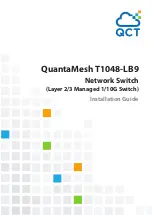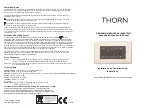
AWPS Quick Install Guide
8
1.
Introduction
Overview of AWPS Series Web Smart PoE Switches
In this user’s manual, we will explain how to configure and monitor the AWPS Series switches
through the Web Management Interface.
The AWPS Series, the next generation Web Smart switches from Alloy, are a portfolio of affordable
Web Smart switches that provide a reliable infrastructure for your business network.
These high performance Gigabit Ethernet switches are ideally suited for smaller networks as their
primary switch, or as a departmental switch in larger networks. With the added flexibility of
supporting both 100Mbps and 1000Mbps SFP Modules these switches can be integrated quickly and
easily into your existing networking infrastructure.
The SFP slots on the switches support all types of Fast Ethernet and Gigabit SFP modules - 100Base-
TX Copper or 1000Base-T copper UTP as well as multimode, single mode and WDM network
connectivity over fibre optic cable - enabling copper or fibre uplinks.
With a wide range of web smart management features, the AWPS series is the perfect choice for
applications that do not require the full functionality of a SNMP Managed switch. Web Smart
features include VLAN’s, Port Trunking, STP/RSTP, IGMP Snooping, Port Mirroring, Loop Detection,
Broadcast Storm Protection and much more.
Switch Architecture
The switch performs at wire-speed, non-blocking switching fabric. This allows wire-speed transport
of multiple packets at low latency on all ports simultaneously. The switch also features full-duplex
capability on all ports, which effectively doubles the bandwidth of each connection.
This switch uses store-and-forward technology to ensure maximum data integrity. With this
technology, the entire packet must be received into a buffer and checked for validity before being
forwarded. This prevents errors from being propagated throughout the network.
Network Management Options
The switch can also be managed over the network with a web browser or Telnet application. The
switch includes a built-in network management agent that allows it to be managed in-band using
SNMP or RMON (Groups 1, 2, 3, 9) protocols. It also has an RJ45 console port connector on the front
panel for out-of-band management. A PC may be connected to this port for configuration and
monitoring out-of-band via a null-modem serial cable. (See Appendix B for wiring options.)
NOTE:
For a detailed description of the management features, refer to
the
User’s manual
.










































